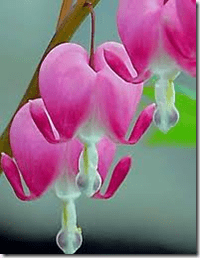-
Bleeding hearts add charm and whimsy wherever they’re planted. Old fashioned bleeding heart (Dicentra spectabilis) is a loose, billowy plant, with arching stems of heart-shaped, pink-and-white flowers in spring. Fringed bleeding heart (D. eximia) is a native American wildflower. Bluish-green, ferny leaves are topped by erect spikes of dark pink flowers from late spring to fall. Both plants perform best in partial to full shade and moist soil conditions.
Fertility
-
Bleeding hearts are long-lived pants that in nature grow in rich woodlands. Give them the same fertile soil in your garden by adding plenty of organic material, such as compost or peat moss when preparing the planting bed. The University of Illinois Extension Service recommends spreading 3 to 4 inches of organic material over the soil and mixing it in to a depth of 10 to 12 inches. In addition, mix 2 lbs.of 5-10-5 fertilizer per 100 square feet into the soil. Once established, side-dress your bleeding hearts each spring with more organic material and fertilizer.
Drainage
-
The addition of organic material also helps keep the soil in your garden well-drained. Both old fashioned bleeding hearts and fringed bleeding hearts need soil that drains well, especially in winter. If your garden is located in a spot that does not drain well, consider building a raised bed. Use rocks, landscape stones, or timbers to construct retaining walls, then fill with enriched soil before planting.
Moisture
-
Both types of bleeding hearts grow best in damp conditions. Water often enough to keep the soil moist but not soggy. Spread a 2- to 3- inch layer of organic mulch around the plant to conserve moisture, but keep the mulch 1 inch away from the plant’s crown. Old fashioned bleeding hearts go dormant in midsummer in most parts of the country, but soil dryness will cause premature dormancy, shortening the flower display.


Deprecated: strpos(): Passing null to parameter #1 ($haystack) of type string is deprecated in /home/agriviek8Qv/agriviet.net/public_html/wp-includes/comment-template.php on line 2522